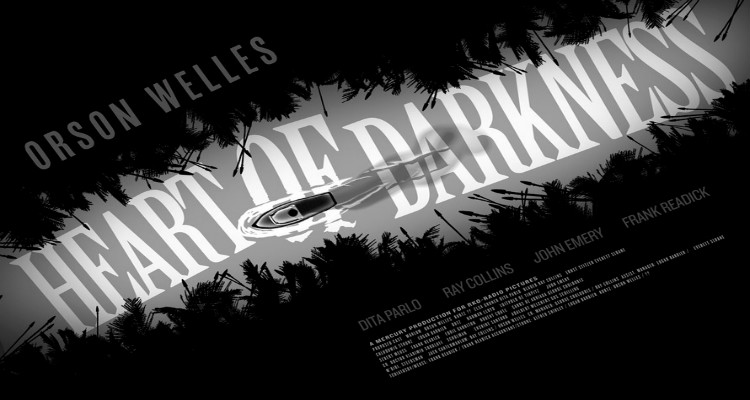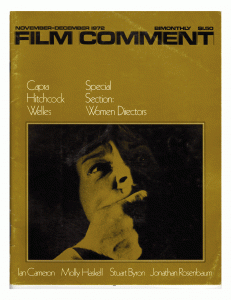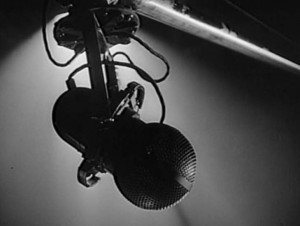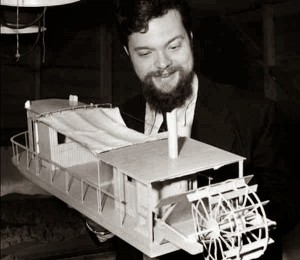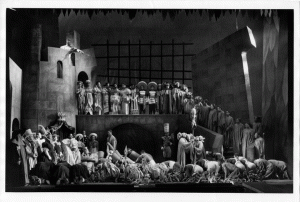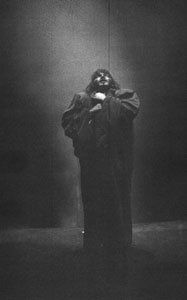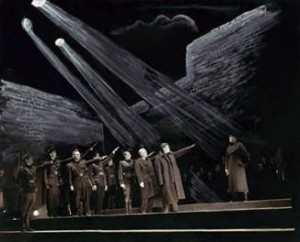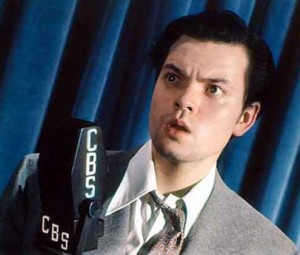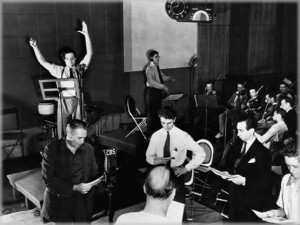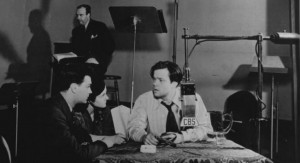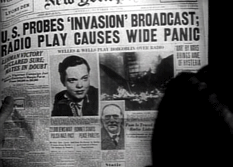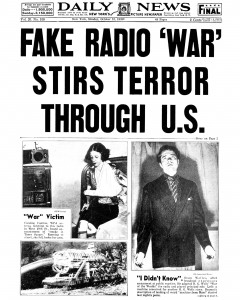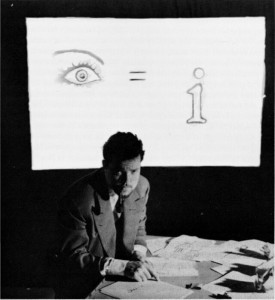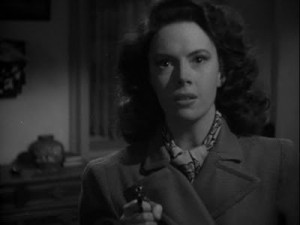From Film Comment, November-December 1972 and Discovering Orson Welles (California, 2007) — the latter of which includes the following introduction. My apologies for some occasional glitches in the formatting, which I haven’t managed to rectify. — J.R.
The following article was inspired by my having been lent Welles’s first film script by the late, Cuban-born film critic Carlos Clarens while we were both living in Paris. This was supplemented eventually by my meeting with Welles, and initially by research in the library at that city’s American Center and correspondence with Richard Wilson, a longtime Welles associate who was probably unique among his close collaborators in his scholarly meticulousness (as evidenced in his suberb rebuttal to an article by Charles Higham about IT’S ALL TRUE, appropriately entitled “It’s Not Quite All True,” in the Autumn 1970 issue of Sight and Sound — an essay that lamentably had no sequels)
As a former graduate student at the State University of New York at Stony Brook in English and American Literature (1966-69) who had dropped out shortly before moving to Paris, I was still somewhat under the sway of that academic training when I wrote this piece, which partially accounts for its literary orientation. (In fact, Jonah Raskin, whose essay on Heart of Darkness is cited in footnote 6, had been one of my Stony Brook teachers.) I regret the awkward use of asterisks to indicate in some cases which of my facts came directly from Welles, a likely consequence of the last-minute additions and revisions occasioned by our meeting.
About 25 years after this article was written, I sent a copy of it to Walter Murch as one of several materials (along with some Welles radio shows) to use as “stylistic reference points” for the new sound-mix he was planning for the opening shot of TOUCH OF EVIL, based on indications of Welles in a studio memo (see Chapter 21) — with specific reference to the “snatches of sound and music, the beginning of life of the city at night” in Manhattan quoted early on.
The Voice and the Eye: A Commentary on the Heart of Darkness script
Early last July, a week before the completion of this article, I had the unexpected privilege of meeting Welles for lunch in Paris, where he was busy editing a new film entitled HOAX, which has something to do with the Clifford Irving/Howard Hughes scandal. (“Not a documentary,” Welles assured me, but “a new kind of a film” — although he didn’t elaborate.) As other commentators have observed, the search for the truth about any Welles project is an endless trip through a labyrinth; possibly no other living director has been the subject of so many conflicting accounts, in large matters as well as small ones. To indicate my sources, all the information given to me by Welles is either stated explicitly or indicated by an asterisk. Unless otherwise noted, the remaining facts about the Heart of Darkness project come from either. Richard Wilson or the script itself. (The interpretations, needless to say, are all my own.) Wilson, who was with Welles in Hollywood for most of this period, has generously supplied me with material from the early Welles-Mercury files. I am also indebted to Carlos Clarens for lending me his copy of the script.
I: The Voice
I…became aware that that was exactly what I had been looking forward to — a talk with Kurtz…The man presented himself as voice …The point was in his being a gifted creature, and that of all his gifts the one that stood out pre-eminently, that carried with it a sense of real presence, was his ability to talk, his words…
— Marlow in Conrad’s Heart of Darkness
Appropriately, Orson Welles’s first Hollywood project begins as a primal initiation: his voice in darkness, followed by an iris opening out into a bird cage. With a master magician’s instinct, he leads us directly from estrangement to entrapment — carrying us in the space of seconds from radio into cinema.
The “revised estimating script,” from which the preceding introduction is taken, runs to 184 pages and is dated November 30, 1939. Although no author is listed on the title page, it is clear from the existing evidence that it was written and adapted by Welles alone. (1) The previous November, shortly after his Halloween eve broadcast of The War of the Worlds, Welles had present Heart of Darkness on Mercury Theatre of the Air as the ninth and next to last program in the series (War of the Worlds was the seventh); like the earlier adaptation, it was scripted by Howard Koch (2), with the probable editorial assistance of John Houseman. According to Welles’ the radio version — in which he played both Marlow and Kurtz –- was weak, and except for the parts that came from Conrad, its influence on the screenplay was minimal . Without the availability of Koch’s script, this cannot be verified.
The central drama of Heart of Darkness revolves around the myth of virtually unlimited power, achieved by Kurtz, an ivory agent, in the depths of the Congo, where he becomes a god to the natives. The story is narrated by Marlow, a skipper hired by the ivory company, and the plot mainly consists of his long journey down the river towards Kurtz. As with the central character of The Great Gatsby, our total sense of Kurtz comes to us filtered through the narrator’s consciousness; he looms in the story as a mysterious figure of rumor and conjecture, and his meaning becomes the sum of everything that Marlow sees and experiences on his way into the jungle. In Conrad’s novella, the actual appearance of Kurtz is somewhat anticlimactic, and is handled rather elliptically; in Welles’s script, it becomes the dramatic climax that all the preceding action builds up to.
Welles said that he originally planned to play only the part of Marlow, hoping he could find someone else for the part of Kurtz. By the time the final estimating script had been written, however, he had decided to take on both parts. As a penetration into the mystery of a powerful, legendary man, Heart of Darkness clearly prefigures CITIZEN KANE; exploring the tension between Marlow and Kurtz, Welles was obviously interested in expressing the same sort of ambivalence about power and position that informs his later films. To make this concern more personal and immediate, he updated Conrad’s story to the present, made Marlow into an American, and explicitly linked Kurtz’s despotism to the tyranny that was currently sweeping over Europe. As Marlow, he would figure primarily as Narrative Voice and unseen hero, glimpsed only occasionally as a reflection or, between episodes, back on his boat in the New York harbor, telling the story. As Kurtz, he would also remain offscreen for most of the film, but then make a grand demonic appearance at the climax.
Welles deliberately pointed up the doppelgänger aspect of this dual role by frequently drawing attention to the physical resemblance between Marlow and Kurtz in the dialogue; expanding the part of Kurtz’s unnamed fiancée into a full-fledged heroine named Elsa (3), he even created a love triangle of sorts. Thus, broadly speaking, the multiple equations proposed by the introduction, whereby I = eye = camera = screen = spectator, are extended still further in the script proper so that spectator = Marlow = Kurtz = Welles = dictator — a notion that is at once so abstract and so audacious that, coupled with a million dollar budget, 82-day shooting schedule and the outbreak of World War II, it is hardly surprising that RKO shelved the project. Welles told me he later learned the primary resistance came not from George Schaefer — the president of RKO, who’d brought him to Hollywood — but the other studio heads.
The roots of the script can be traced through much of Welles’s theater and radio work in the late Thirties. In 1936, he had already conjured up a sinister atmosphere of jungle tribalism in his “voodoo” stage production of Macbeth, set in Haiti with an all-Negro cast. The following year, he played the title role in his staging of Dr. Faustus — a character who quite likely contributed to his conception of Kurtz — and then played Brutus in his modern-dress Julius Caesar, which was particularly noted at the time for its contemporary political parallels (fascist-style uniforms and salutes, “Nuremberg lighting,” etc.) But the importance of his radio work was probably even more decisive. The first Mercury radio series, First Person Singular, broadcast eight programs in the summer of 1938 and introduced a narrative technique that was, at the time, completely new to the medium. Newsweek ran a brief story about the show on the day that it premiered (July 11):
Avoiding the cut-and-dried dramatic
technique that introduces dialogue with
routine announcements, Welles will serve
as genial host to his radio audience. As
narrator, he will build himself directly
into the drama, drawing his listeners
into the charmed circle. He reasons:
“This method frees the script writer
from the necessity of attempting to
introduce a description of the locale
into the dialogue…A radio audience is
apt to be bored when it hears someone say,
`Once upon a time.’ Not so if you say,
‘This happened to me.'”
This first-person technique was carried over into subsequent Welles radio series; it was even used prominently in the second half of the War of the Worlds broadcast — which few people heard at the time. Apart from anticipating the use of subjective camera, and implying an autobiographical link between Welles and his heroes, this method leads to a form of narrative economy — encapsulating exposition and bridging scenes — that is essential to Welles’s early film work. (The use of overlapping dialogue — as prominent in the Heart of Darkness script as in his subsequent films — also derives from radio.)
The opening of the script seems particularly rich with radio devices. Over a long shot of the New York harbor at dusk, Marlow’s voice begins with a passage drawn from the sixth paragraph of Conrad’s story, converted from past to present tense:
The old river in its broad reach rests unruffled at the decline of day, after ages of good service done to the races that people its banks, done to the races that people its banks, spread out in the tranquil dignity of a waterway leading to the utmost ends of the earth.
The narration continues over dissolves showing the river traffic and Manhattan Island, and “lap dissolves” of the “great bridges of both rivers,” “parkways,” “boulevards” and “skyscrapers,” each seen at the instant that their lights are illuminated. In the next sequence, “as we move down the length of the Island” — a passage more impressionistic in visual detail than most of the rest of the script — Marlow’s voice is joined by “snatches of sound and music, the beginning of life of the city at night”:
In Central Park, snatches of jazz music are heard from the radios in the moving
taxicabs. The sweet dinner music in the restaurants of the big hotels further
West. The throb of tom-toms foreshadow the jungle music of the story to come. The
lament of brasses, the gala noodling of big orchestras tuning up in concert halls
and opera houses, and finally as the camera finds its way downtown below
Broadway, the music freezes into an expression of the empty shopping district
of the deserted Battery — the mournful muted clangor of the bell buoys out at sea, and the hoot of shipping.
The continuing narration is basically an abridgement of Conrad’s text, adapted from a European to American context:
I was thinking of very old times when our fathers first came here, four hundred years ago — the other day…Imagine the feelings of a skipper[…], a civilized man, four hundred years ago, hove to off the Battery here — at the very end of the world. Imagine the trip up this river. With death skulking in the air, in the
water, in the bush. They must have been dying like flies[…].
(In the original, “our fathers” was “the Romans,” “four hundred” was “nineteen hundred,” “skipper” was “commander,” and “the Battery” was “the sea-reach of the Thames.”) Towards the end of this lengthy speech, we arrive at Marlow’s boat, and see Marlow leaning against the mast while he speaks, the Manhattan skyline glimpsed behind him. As he relights his pipe, there is a dissolve to a reflection of him lighting his pipe in a shop window while the narration continues offscreen, and Marlow’s story and the subjective camera treatment both begin: “I was over in Europe — ” (the match flares; dissolve) “ — loafing around one of the big port towns looking for a ship — when I saw that map in a shop window.” Throughout this opening, the narrative continuity is guided and controlled by the sound.
The legacy of Welles’ radio work is vast — from July 1938 to March 1940 alone, he adapted, directed, narrated, and acted in nearly eighty radio plays. Unfortunately, the only recording from this period that is generally available today is The War of the Worlds. And according to Welles, even that performance is not the one that was broadcast, but one given at another time.
The likely impact of this broadcast on Heart of Darkness cannot be overstressed. It is estimated that 6 million people heard the program and 1,200,000 of them took it literally, believing that America had just been invaded by Martians; an unknown number of people who didn’t hear the broadcast were likewise caught up in the hysteria. (5) At the age of 23, Welles was suddenly catapulted into a position of nation-wide fame and notoriety, which led to both a commercial radio sponsor (Campbell Soup) and a Hollywood contract granting him an unprecedented degree of artistic and financial control. When he arrived in Hollywood thirteen months after the broadcast — four months prior to the completion of the script — he was an unusually controversial and powerful figure, and the immediate dislike he attracted in the movie colony undoubtedly amplified this image. During the same month that he signed with RKO, Germany signed a nonaggression pact with the Soviet Union and invaded Poland; while he was preparing Heart of Darkness, the war broke out; and the relation between his own rapid ascendancy and (in his case, unwitting) sway over the masses and Hitler’s was surely not lost on him. Marshall McLuhan’s description of this relation in Understanding Media is, like many of his pronouncements, somewhat facile; but as an evocation of radio’s power during this period, it bears repeating:
The subliminal depths of radio are charged with the resonating echoes of
tribal horns and antique drums. This is inherent in the very nature of this medium,
with its power to turn the psyche and society into a single echo chamber…The
famous Orson Welles broadcast about the invasion from Mars was a simple
demonstration of this all-inclusive, completely involving scope of the auditory
image of radio. It was Hitler who gave radio the Orson Welles treatment for real.
Hitler is never cited by name in the Heart of Darkness script, but his relation to Kurtz is nonetheless unmistakable — coming to the fore in the final pages, when Kurtz remarks, “There’s a man now in Europe trying to do what I’ve done in the jungle. He will fail.” A bit earlier, we find this exchange:
KURTZ: I have another world to conquer.
MARLOW’S VOICE: What world?
KURTZ: Down the river. Five more continents and then I’ll die —
More generally, the alliance is expressed indirectly, as in Marlow’s medical examination near the beginning, when Welles’s two major additions to Conrad are explicitly racist remarks from the doctor to be played by Everett Sloane* (while examining Marlow’s head: “Mmm…Good Nordic type…the superior races you know”) and an early reference to Kurtz, whom the doctor identifies as “our next leader.” Later, when Marlow and the company men (who are all Germans in the script) come upon a row of poles supporting human heads in a foggy swamp, the station manager De Tirpitz to be played by George Coulouris* says, “That’s how Kurtz and the rest of them got their power back in Europe. This shouldn’t surprise you. You’ve seen this kind of thing in the city streets.”
Conrad’s story, largely based on his experiences in the Congo, has a political tonality of its own, and one critic has argued persuasively that it can be read — at least in part — as a critique of imperialism. (6) (It is interesting to note that Welles originally wanted to shoot the film on location, and designed it for studio shooting only after RKO rejected the idea.*)
At the same time that Welles was writing the script, Chaplin was beginning to shoot THE GREAT DICTATOR, another project centered around a double role of dictator and putative hero. But while Chaplin, the more extroverted of the two, was using himself to confront Hitler, it appears that Welles, the more introverted and intellectual artist, was partially using Kurtz to confront the darker side of himself. The climactic speech of Chaplin’s film is delivered by the Jew; the equivalent speech in Welles’s script is given by Kurtz, immediately before his death:
KURTZ: […] I’m a whole nation’s long, golden dream. — And to you — a miserable
wretch you once caught, grubbing for ivory in the bush, crazy with disease, who died on you in captivity.
MARLOW’S VOICE: You’re more than that.
KURTZ: Or less?
MARLOW’S VOICE: Or worse.
KURTZ: Or worse…
MARLOW’S VOICE: How do you know you’re going to die?
KURTZ: What I’ve had is fatal — it’s called power…Do you understand that? I think so —
MARLOW’S VOICE: You said I never would.
KURTZ: You’ll never understand Kurtz — the statue in the public park. And there’ll
be one — a big one in very bad taste, and on this day, every year, they’ll make speeches and lay wreaths at my stone feet. And then the young men will go off and get drunk singing a song about me. — No, you’ll never understand that. — Not what they make of me. But you can see what I’ve made of myself.
MARLOW’S VOICE: You said you ran away. I don’t understand that.
KURTZ: I was afraid. — Understand this much. — Everything I’ve done up here has been done according to the method of my Government. — Everything. There’s a man now in Europe trying to do what I’ve done in the jungle. He will fail. In his madness he thinks he can’t fail — but he will. A brute can rule only brutes. Remember the meek — the meek. — I’m a great man, Marlow — really great — greater than great men before me — I know the strength of the enemy — its terrible
weakness. The meek — you and the rest of the millions — the poor in spirit. I hate you — but I know you for my betters without knowing why you are except that yours is the Kingdom of Heaven, except that you shall inherit the earth. Don’t mistake me. I haven’t gone moral on my death bed. I’m above morality. No, I’ve climbed higher than other men and seen farther. I’m the first absolute dictator. The first complete success. I’ve known what the others try to get. I’ve gotten it in the one place in the world where it could be got. I’m the man on top — the one man. All the rest are six feet underground where I buried them. That’s the game. Bury the rest of them alive. Stay on top yourself. I won the game, but the winner loses too. He’s all alone and he goes mad. (There is a flash of lightning, followed by a clap of thunder.)
KURTZ (continued): That’s why I ran away. I ran from the face of darkness, and
then as I started back down the river I saw that there was darkness there, too, and
failure. So I hid in the charnel house where you found me, and then I ran again.
Madness is better than defeat. Down the river is the light of reason, showing still
behind the darkness, marking the evil, marking the shape of the original lie. I
sound moral again. I’m not. I’m just practical. I know when to die. (Lightning
and thunder.)
KURTZ (continued): I thought the time had come for me. The sun was low over the world, and my shadow was long, it would cover everything. I know now it’s not long enough. No man’s is long enough. The strong die with their dream. I am the first to die awake. (Lightning and thunder.)
KURTZ (continued): Our shadows are dark like night, and where they fall the jungle grows again. But the sun always goes down. Mine did. And the world has a darker shadow — darker than mine. I’m going to die before daybreak — I’m afraid to live. The dawn might find me a very little man. (Kurtz has shifted his gaze. Now he is staring, not towards camera lens, but beyond it, his eyes very wide.)
MARLOW’S VOICE: Kurtz! — Kurtz! (Lightning and thunder.)
MARLOW’S VOICE (continued): What are you looking at?
KURTZ: The horror! — The horror!
***
II: The Eye
The yarns of seamen have a direct simplicity, the whole meaning of which
lies within the shell of a cracked nut. But Marlow was not typical (if his
propensity to spin yarns be excepted), and to him the meaning of an episode was not inside like a kernel but outside, enveloping the tale which brought it out only as a glow brings out a haze, in the likeness of one of these misty -halos that sometimes are made visible by the spectral illumination of moonshine.
— Conrad’s Heart of Darkness
The cinema is an anti-universe where reality is born out of a sum of unrealities.
–Jean Epstein
Since the release of Robert Montgomery’s LADY IN THE LAKE in 1946, the critical consensus about continuous use of the first-person camera has been consistently negative. To inquire whether Heart of Darkness would or could have changed these objections is to ask an unanswerable question: scripts are blueprints, not finished works, and even to discuss one that was never filmed is to give it an identity of its own that was never intended.
Considering RKO’s reluctance about Heart of Darkness, it is possible that the script’s introduction [see Appendix] was partially designed to placate the studio about the film’s commercial possibilities, leavening its experimental nature with a heady dose of showmanship. One of its showier aspects is the use of color — the gun that “goes off with a cloud of smoke and a shower of brightly colored sparks,” and the “blinding red stain” and “dirty violet” during the electrocution sequence. Welles explained to me that color was planned only for separate shots such as the above; the remainder of the film was to be in black-and-white.
Whatever the ultimate strategies behind the introduction, it remains a remarkable document, and a useful path leading into the script proper. For one thing, it serves the ingenious function of demonstrating the playful and gimmicky aspects of the technique before the story begins, thus clearing the way for its subsequent use as a serious narrative device. In the remainder of the script, aside from a few comic moments — such as in Marlow’s medical examination, when the doctor, in closeup, extends his calipers toward the camera “like an enormous insect threatening its victim with legs and antennae” — the technique remains functionally neutral throughout, rarely calling attention to itself. An attraction between Marlow and Elsa is faintly implied, but the script spares us the embarrassment of any kissing scenes.
Indeed, despite the heated rhetoric of the Conrad-derived narration that he delivers, Marlow usually figures in the action as a neutral, uncommitted observer, thus enabling the camera to serve a relatively modest role as recording instrument. (“What are your politics?” he is asked by Eddie, the English representative at the company’s First Station to be played by Gus Schilling.* He replies, “I have no sympathies one way or another. I’m just here to run a boat.”) The semi-invisible reporter in CITIZEN KANE, also emotionally detached, is probably an outgrowth of this idea. Two striking uses of subjective camera in THE MAGNIFICENT AMBERSONS — shots from Wilbur Minafer’s coffin and from the viewpoint of George walking home near the end — each depend on a sense of numbness in the unseen character: literal death in the first case, emotional alienation in the second.
When I asked Welles how he felt about the technique today, he expressed skepticism, and explained that he became somewhat disillusioned with it after shooting a long subjective sequence in AMBERSONS — one moving through the family mansion, apparently meant to follow George’s final walk home, which was cut from the film.
An obvious drawback to the technique for Welles is that it would have restrained the use of the camera as an independent expressive device — a central aspect of his later style. At one point in the script, as if in anticipation of this development, the camera does break away from Marlow’s impassivity to forge a statement of its own, in a passage that exemplifies Welles’ attempts to illustrate the narration cinematically. At the end of a long sequence detailing Marlow’s arrival at the First Station — after meeting Elsa and Eddie, and witnessing the maltreatment of natives, the pettiness of the company men (mainly shown as comic bumpkins), and the callowness of Blauer, the station manager to be played by Robert Coote,* who complains that the groans of a dying man on a mattress outside his office “make it difficult to work” — Marlow leaves Blauer’s office, and the transition is effected in the following way:
Blauer’s voice which has started to fade from the soundtrack is now overwhelmed
by MUSIC. This music makes reference to Blauer’s voice, to the groans of the
dying man, to the tinkle of Eddie’s piano [featured prominently in the previous scenes — J. R.], to the somber overtones of the New York harbor. Blauer is seen to be still talking, but we cannot distinguish what he says. As this happens CAMERA STARTS TO PULL BACK smoothly but swiftly. Simultaneously […], Blauer’s image begins to wash out. CAMERA MOVEMENT SLOWS UP a little when it gets outside door of Blauer’s office and then CAMERA STARTS TO RISE (ON THE CRANE) slowly and solemnly, but ANGLES DOWN to the floor so that we again see the dying man.
This is the last clear impression we get on the fading interior.
Dissolve
Exterior Settlement, Harbor and Jungle-Night — (Miniature) CONTINUATION OF CRANE SHOT. CAMERA CONTINUES THE UPWARD MOVE (matching its rising action on the interior shot). It MOVES UPWARD from the Manager’s building and takes into the shot a view, from above, of the whole settlement. Still MOVING UPWARD, CAMERA PANS to take in the harbor, with the steamer far below loading in the glare of electric lights. CONTINUING THE MOVE UPWARD, it clears the harbor and takes in the black wall of the jungle beyond.
Wipe
Exterior Starry Sky — Night — (Painting)
CAMERA, MOVING UPWARD, comes now to a shot of the starry sky, which fills the entire frame.
Dissolve Out
Exterior Starry Sky — Night –(Painting) The dark grey shadow of Marlow SUPERIMPOSES itself over the shot of the starry sky. He is leaning against the mast of his boat and smoking his pipe. The shadow takes the pipe out of its mouth and the music introduces Marlow’s voice.
MARLOW’S VOICE (narrating): That man inside jabbered about his Mr. Kurtz, and outside the silent wilderness surrounded this cleared speck on the earth, great and invincible, like evil or truth — waiting patiently […]
Montgomery’s use of subjective camera floundered on the mistaken notion that it would permit the audience to “identify” with his hero. Welles’s concept, while partaking of this notion, seems based on an attraction-repulsion principle that is not only much more complex, but — unlike Montgomery’s — organically related to the concerns of the plot. This, too, is prefigured in the introduction [see Appendix]: in quick succession, the viewer is isolated from his neighbors, caged, shot, electrocuted, turned into an incompetent golfer, and then replaced by a movie camera. The disquieting image of an audience composed of cameras attests to the solipsistic nature of the conception, yet the spectator is teased and cajoled in such grand style that he is theoretically seduced into playing the game — without being allowed to forget that he is playing it.
In the story that follows, the sensationalism of the technique is partially supplanted by the sensationalism of the plot, and the attraction-repulsion principle becomes central to the dialectic between Marlow and Kurtz. Thus, while we are trapped within Marlow’s circumscribed gaze as he travels through a studio-built Africa, hearing awed reports about the power and grandeur of Kurtz, we are gradually lured into wanting to share Kurtz’s vision instead. And when we come upon the depraved person of Kurtz, we are presumably driven back by fear into an identification with Marlow — or, more likely, compelled to form a split identification between the two of them. The climactic meeting of Marlow and Kurtz is rich with suggestions:
Exterior Lake and Temple — Moonlight — (Fog) […] CAMERA MOVES toward the temple as the canoe glides toward it, HOLDING on it, ANGLING from below until the canoe nears its base. CAMERA finally COMES CLOSE to ladder which extends up to floor of temple. Now, indicating that Marlow is climbing the ladder, CAMERA TRAVELS UPWARDS. We catch in the background the texture of the water and light, as well as the pattern of the pilings under the temple. As CAMERA MOVES UPWARDS, it TILTS UP to SHOT of the temple ceiling, showing it is covered with skulls. Then CAMERA PANS DOWN off the ceiling and we
Feather Wipe
Interior Temple — Moonlight — (Miniature) CONTINUATION OF PAN DOWN from skull-covered ceiling to a LONG SHOT of the temple. The skull-and-bone decoration is carried throughout the interior. The place is dark, the source of light coming from the moon which shines in through the open front. At the far end of the structure, we discern a throne on a platform, and seated on the throne, the figure of a man — Kurtz. CAMERA TRUCKS FORWARD as Marlow starts walking toward the throne, and we
Dissolve Out
Interior Temple — Moonlight — (Set) CAMERA is now much closer to Kurtz on the throne and is still MOVING FORWARD, Marlow having covered the long walk from front of temple in the dissolve. Kurtz is more distinct, and as we near him CAMERA TILTS UP SLIGHTLY to indicate that he is on a higher level than Marlow. We end up in a MEDIUM CLOSEUP of Kurtz.
KURTZ: Have you a cigarette? (He reaches out for the cigarette. His hand goes below frame of camera. He brings his hand back with the cigarette in it and puts the cigarette into his mouth.)
KURTZ (continued): Light it for me —
CAMERA MOVES FORWARD and UPWARD into EXTREME CLOSEUP of Kurtz’s face. There is the flare of a match as Marlow lights the cigarette.
KURTZ (continued): I’m dying — (he looks keenly into lens of camera, straight into Marlow’s eyes): You’re American. What’s your name?
MARLOW’S VOICE: Marlow.
KURTZ: I’m Kurtz. You look like me — a little —
(On the words “a little” CAMERA MOVES BACK SLIGHTLY and LOWERS a TRIFLE from the extreme closeup of Kurtz’ face, indicating that Marlow has stepped down and back. Kurtz settles back on his throne.)
KURTZ (continued): (looking straight at Marlow): — The image of God — I can use you — […]
Throughout my conversation with Welles, it was clear that the Heart of Darkness project was still very dear to him, despite the pain and frustration it had cost him, and his later disenchantment with the subjective camera technique. As he wondered at length why no good film has ever been made from Conrad — regarding Brooks’s LORD JIM and Reed’s OUTCAST OF THE ISLANDS with equal disdain and discussed his prolonged efforts to find another actor to play Kurtz, it was easy to see the fascination that the project still held for him. He stressed the fact that he was just on the verge of beginning to shoot the film when the project was cancelled — having already shot tests of the first-person technique with Sloane, Schilling, Coote, and himself* — and it seemed to linger in his memory as one of many Rosebuds, a dream that he had continued to nurture even after the completion of CITIZEN KANE.
Perhaps, in the confrontation between Marlow and Kurtz, we would have wound up identifying with neither character. To have brought off such a scene with eliciting a single snicker would have required genius. Yet given the scope of Welles’ talent —and the rare energy and enthusiasm with which he attacked his first Hollywood project — can we claim with absolute assurance that he couldn’t have done it?
End Notes
1. According to Joseph McBride (Orson Welles, London: Secker and Warburg, 1972), Welles wrote the script with John Houseman; in “Raising Kane” (The Citizen Kane Book, Boston: Atlantic-Little Brown, 1971), Pauline Kael writes that “it was reported in the trade press that [Welles] was working on the script with John Houseman and Herbert Drake, who was Mercury’s press agent.” However, John Houseman’s recent memoir, Run-Through (New York: Simon and Schuster, 1972), makes it clear that he did not share in the authorship; and Richard Wilson has written me that the revised estimating script “is entirely by Welles.”
2. This information was conveyed to me by Richard Corliss, the editor of Film Comment, who learned it from Koch himself.
3. Welles used the name Elsa again for the heroine of THE LADY FROM SHANGHAI, played by Rita Hayworth. The Elsa in Heart of Darkness was to have been played by Dita Parlo, an Austrian actress; but this subsequently became impossible when she was interned in France as an enemy alien. (Roy A. Fowler, Orson Welles: A First Biography, London, Pendulum, 1946). In the script, Elsa insists on accompanying Marlow and the company men down the river, but Marlow sends her back to the First Station for safety after De Tirpitz reports back that the members of the Third Station have been decapitated, and they start to hear war drums.
4. In Run-Through, Houseman gives a fascinating account of the radio shows, and describes the Mercury recordings Welles made for Columbia Records of Julius Caesar, The Merchant of Venice and Twelfth Night –– complete performances, with music and sound effects-in 1938. Welles’ production of Marc Blitzstein’s The Cradle Will Rock was available on a long-playing record released several years ago. Cf. Joseph McBride’s Orson Welles for an extensive (though “probably incomplete”) listing of Welles’ radio work.
5. These figures come from Invasion from Mars, a study by Hadley Cantril and his research staff at Princeton; cited in The Panic Broadcast, by Howard Koch, Avon Books, 1970.
6. “Imperialism: Conrad’s Heart of Darkness,” by Jonah Raskin, Journal of Contemporary History, Vol. 2, Number 2, April, 1967.
7. According to Charles Higham, (The Films of Orson Welles, Berkeley: University of California Press, 1970), the film was to be shot with hand-held Eyemo cameras. Ray Collins and Erskine Sanford were also to have figured in the cast.
***
Appendix: Introductory Sequence to the Heart of Darkness script by Orson Welles
Heart of Darkness
Revised Estimating Script
Introduction
This has no direct connection with the motion picture itself. It is intended to instruct and acquaint the audience as amusingly as possible with the special technique used in “The Heart of Darkness.”
INTRODUCTION
After regular RKO trademark title, followed by Mercury title,
Fade Out
Dark Screen
WELLES’ VOICE: Ladies and Gentlemen, this is Orson Welles. Don’t worry. There’s just nothing to look at for a while. You can close your eyes, if you want to, but–please open them when I tell you to… First of all, I am going to divide this audience into two parts — you and everybody else in the theatre. Now, then, open your eyes.
Iris Into
Interior Bird Cage-(Process)
1 SHOOTING FROM inside the bird cage, as it would appear to a bird inside the cage, looking out. The cage fills the entire screen. Beyond the bars can be seen chin and mouth of Welles, tremendously magnified.
WELLES’ VOICE: The big hole in the middle there is my mouth. You play the part of a canary. I’m asking you to sing and you refuse. That’s the plot. I offer you an olive.
A couple of Gargantuan fingers appear from below cage and thrust an enormous olive toward CAMERA, through bars of the cage.
WELLES’ VOICE (cont’d): You don’t want an olive. This enrages me.
Welles’ chin moves down and his nose and eyes are revealed. He is scowling fiercely.
WELLES’ VOICE (cont’d): Here is a bird’s-eye view of me being enraged. I threaten you with a gun.
Now the muzzle of a pistol is stuck between the bars of the cage. It looks like a big Bertha.
WELLES’ VOICE (cont’d): That’s the way a gun looks to a canary. I give you to the count of three to sing.
Welles’ head moves up, showing his mouth on the words, “one, two, three.” His voice is heard over echo chambers and the narration is synchronized on the count with the movement of his lips.
WELLES’ VOICE (cont’d): One — (on normal level) That’s the way I sound to you, you canary. (on echo again) Two — three. (on normal level, cheerfully) You still don’t want to sing so I shoot you.
The gun goes off with a cloud of smoke and a shower of brightly colored sparks. As this fades out,
WELLES’ VOICE (cont’d):
That’s the end of this picture.
Fade Out
Fade in
Credit Title
RKO Caption, THE END. Conclusive chords of music finishing off as we
Fade Out
Black Screen
WELLES’ VOICE: Now, of course, this movie isn’t about a canary and I am not going to threaten you with firearms just because you don’t feel like imitating birdcalls, but I do want you to understand that you’re part of the story. In fact, you are the star. Of course, you’re not going to see yourself on the screen but everything you see on the screen is going to be seen through your eyes and you’re somebody else. Understand? — No? — Let’s take a screen test: Close your eyes. Now, — open up.
Iris Into
Interior Prison Corridor and Death Chamber
2 SHOT of prison bars. Welles appears on other side of bars. This time, what he says is synchronized.
WELLES: This isn’t a bird’s-eye view again. This is a convict’s-eye view. You’re in jail.
Welles puts on a Warden’s cap.
WELLES (cont’d): I’m the warden.
Welles unlocks cell door. Bars swing away from CAMERA. Welles moves in to CAMERA, staring directly into lens.
WELLES (cont’d): (as Warden) All right, it’s time now. Come on. (pause; then fiercely) Come on!
CAMERA TRUCKS thru doorway into corridor. Welles steps aside. CAMERA, on normal eye level, MOVES AROUND and confronts prison attendants and Chaplain who are moving toward CAMERA. Very legitimate. CAMERA STOPS.
WELLES’ VOICE (cont’d): Let’s go.
Jailers turn directly away from CAMERA and start moving away.
WELLES’ VOICE (cont’d): Let’s go.
Chaplain steps slightly aside to make way for CAMERA, still looking into it.
WELLES’ VOICE (cont’d): Come on, march!
CAMERA DOLLIES down corridor after guards and past Chaplain, who disappears from frame. Footsteps to match this action. After CAMERA MOVES several feet, a voice is heard.
PRISONER’S VOICE: Hey!
CAMERA CONTINUES moving forward, but somewhat slower.
PRISONER’S VOICE (cont’d): Hey! (louder) Hey!
Guards turn around, look at CAMERA, then turn to their left in direction of the voice.
PRISONER’S VOICE (cont’d): You!
CAMERA PANS around and centers on a very murderous looking customer peering through the bars of a cell.
PRISONER (cont’d): Yes, you. (he smiles) I’m next.
WELLES’ VOICE: Shut up, Riley.
PRISONER: Yes, Sir.
WELLES’ VOICE: Keep marching, you.
CAMERA PANS back to corridor and TRUCKS FORWARD, the guards preceding it. After a while the prisoner’s voice is heard in the distance.
PRISONER’S VOICE: Happy landings!
A colored baritone commences a typical spiritual routine. CAMERA CONTINUES moving forward. The guards in front Of CAMERA come to a halt. One guard turns toward CAMERA, the other starts opening an iron door.
PRISONER’S VOICE (cont’d): I’ll be seeing you.
The baritone stops. The prisoner’s wild laugh comes over on soundtrack.
CAMERA has STOPPED for a moment and now, as the door opens, it TRUCKS into death chamber, confronting more attendants and registering on the far wall, a large clock.
Sound of iron door closing cuts off sound of wild laughter. CAMERA PANS QUICKLY to the left, taking in gallery of grim-looking witnesses, and finishing on other side of the iron door which attendants have just closed.
CAMERA suddenly LISTS sharply to port and then starts toward floor.
WELLES’ VOICE: Steady!
CAMERA’S PLUNGE to the floor is arrested by Warden’s voice. CAMERA SLOWLY RIGHTS ITSELF, still holding on the door.
A clock is heard ticking ominously. CAMERA PANS SLOWLY past witnesses again to the clock, then PANS AROUND to other side of the death chamber to attendants and electrician seated beside his paraphernalia. Attendants, still looking at CAMERA, move aside and disclose electric chajr.
The clock continues its ominous ticking. As CAMERA MOVES, we also hear footsteps to match. CAMERA TRUCKS SLOWLY to electric chair. When we are next to it and looking down at it, CAMERA STOPS.
WELLES’ VOICE: Sit down!
CAMERA PANS AROUND taking in clock but not focusing on it, and confronts witnesses. Then LOWERS a couple of feet to height of sitting position.
WELLES’ VOICE (cont’d): Straps!
Attendants move into frame, make adjustments. They are very close to CAMERA. Sound of straps being fastened.
WELLES’ VOICE (cont’d): Feet!
More sound to match. Then Attendant rises slightly and looks above CAMERA, somewhat to the side.
FIRST ATTENDANT: Yes, sir.
First Attendant straightens and moves out of scene.
Second Attendant rises and does the same.
WELLES’ VOICE: Fasten the head cap!
Sound to match.
WELLES’ VOICE (cont’d): (quietly) Prisoner doesn’t want blindfold. (raising his voice) Have you anything to say? (pause) All right, Joe, take it on the minute.
CAMERA PANS to electrician, then PANS SHARPLY to clock whose long hand is moving towards 12:00.
Ticking louder. Sound of witnesses moving forward in their seats.
CAMERA PANS SHARPLY to their faces. They look into lens, completing their move. One witness takes out a watch, looks at it, looks at his left and towards the clock. Witness next to him follows his eyes toward clock. CAMERA FOLLOWS their move and PANS BACK to clock.
Ticking still louder. The long hand gets to 12:00.
WELLES’ VOICE (cont’d): All right.
Sound of current being turned on. Screen goes into blinding red stain. CAMERA BLURRING ITS FOCUS at the same time, moves quickly to electrician whose outline distorts terribly, melts into dirty violet, and sound of current magnified into terrific metallic ring which completes sound, dies as we
Fade Out
Fade In
Black Screen
WELLES’ VOICE: Ladies and Gentlemen, there is no cause for alarm. This is only a motion picture. Of course, you haven’t committed murder and believe me, I wouldn’t electrocute you for the world. Give yourself your right name, again, please. It might help. All right, now, I think you see what I mean. You’re not going to see this picture — this picture is going to happen to you.
3 A moving picture camera appears, contrasted sharply against the original black of the screen.
WELLES’ VOICE (cont’d): You’re looking at the sky, and remember you’re looking at it!
Camera Pans Down from the sky
Wipe
Exterior Golf Course
4 CONTINUATION OF PAN SHOT DOWN from the sky with clouds, showing the fairway of a golf course and a distant green. PAN QUICKLY DOWN to the ground immediately below, on CLOSEUP of a golf ball and a driver which are in the proper relation to each other under CAMERA. The club starts away from the ball. CAMERA FOLLOWS the club slightly, but is arrested by Welles’ voice:
WELLES’ VOICE: Keep your eye on the ball!
CAMERA PANS BACK to the ball. Club goes up for
another drive, moves out of the frame and into it,
striking the ball. CAMERA PANS, following the ball
as it sails back up into the sky and then descends
into a very palpable rough.
WELLES’ VOICE (cont’d): Topped it, didn’t you?
CAMERA PANS QUICKLY past fairway and AROUND to Welles’ face. He is standing a few feet away, smiling, but as CAMERA settles on him he wipes smile off his face.
WELLES (cont’d): I’m sorry. It was the wind.
Welles moves forward, stopping when he fills frame with MEDIUM CLOSEUP of himself.
WELLES (cont’d): (looking straight into lens) Now, if you’re doing this right, this is what you ought to look like to me.
Dissolve
Interior Moving Picture Theater (Painting)
5 SHOT of inside theatre as it would appear from the stage or rather from the center of the moving picture screen!
Beginning on the projection booth, CAMERA PANS DOWN taking in the orchestra floor of the theatre, dimly lit by the reflected light from the screen. The audience is entirely made up of motion picture cameras. When this has registered:
WELLES’ VOICE: I hope you get the idea.
Fade Out
Fade In
Black Screen
6 A human eye appears on left side of screen Then an ‘equal’ sign appears next to it. The capital “I”. Finally, the eye winks and we
Dissolve

